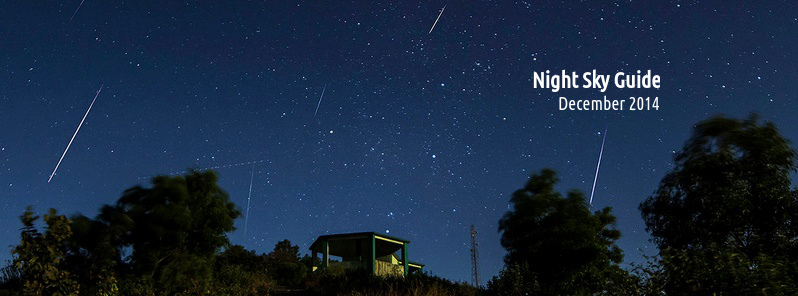Night sky guide for December 2014

The first half of December provides some of the best meteor activity of the year, however, the bright moon will block out all but the brightest meteors. Geminids, the king of the meteor showers, peak on December 13. They will be blocked out by waning gibbous moon to some degree but the Geminids are so bright and numerous that it should still be a good show.
December Solstice will occur at 23:03 UTC on December 21. This will be the first day of winter (winter solstice) in the Northern Hemisphere and the first day of summer (summer solstice) in the Southern Hemisphere.
Two days later, sky watchers can observe Ursid meteor shower. Ursids are minor meteor shower producing only about 5 – 10 meteors per hour, however, 2014 is one of the best years to observe them as there will be no moonlight to interfere.
-
December 6 – Full Moon – 12:27 UTC. This full moon was known by early Native American tribes as the Full Cold Moon because this is the time of year when the cold winter air settles in and the nights become long and dark. This moon has also been known as the Moon Before Yule and the Full Long Nights Moon.
-
December 12 – Conjunction between the Moon and Jupiter. The Moon and Jupiter will make a close approach, passing within 4°53' of each other. At the moment of closest approach, the Moon will be at mag -12.2, and Jupiter at mag -2.3, both in the constellation Leo. The pair will be too widely separated to fit within the field of view of a telescope, but will be visible to the naked eye or through a pair of binoculars. (InTheSky)
-
December 13, 14 – Geminid meteor shower. The Geminids is the king of the meteor showers. It is considered by many to be the best shower in the heavens, producing up to 120 multicolored meteors per hour at its peak. It is produced by debris left behind by an asteroid known as 3200 Phaethon, which was discovered in 1982. The shower runs annually from December 7 – 17. It peaks this year on the night of the 13th and morning of the 14th. The waning gibbous moon will block out some of the meteors this year, but the Geminids are so bright and numerous that it should still be a good show. Best viewing will be from a dark location after midnight. Meteors will radiate from the constellation Gemini, but can appear anywhere in the sky. (SeaSky) Read more…
-
December 15 – NGC 1981 is well placed for observation. The open star cluster NGC 1981 in Orion's sword will reach its highest point in the sky at around midnight local time. At a declination of -04°25', it is visible across much of the world; it can be seen at latitudes between 65°N and 74°S. At magnitude 4.6, NGC 1981 is too faint to be seen with the naked eye from any but the very darkest sites, but is visible through a pair of binoculars or small telescope.
-
December 21 – December Solstice – 23:03 UTC. The South Pole of the Earth will be tilted toward the Sun, which will have reached its southernmost position in the sky and will be directly over the Tropic of Capricorn at 23.44 degrees south latitude. This is the first day of winter (winter solstice) in the Northern Hemisphere and the first day of summer (summer solstice) in the Southern Hemisphere.
-
December 22 – New Moon – 01:36 UTC. The Moon will be directly between the Earth and the Sun and will not be visible from Earth. This is the best time of the month to observe faint objects such as galaxies and star clusters because there is no moonlight to interfere.
-
December 22, 23 – Ursid meteor shower. The Ursids is a minor meteor shower producing only about 5-10 meteors per hour. It is produced by dust grains left behind by comet Tuttle, which was first discovered in 1790. The shower runs annually from December 17-25. It peaks this year on the the night of the 22nd. This will be one of the best years to observe the Ursids because there will be no moonlight to interfere with the show. Best viewing will be just after midnight from a dark location far away from city lights. Meteors will radiate from the constellation Ursa Minor, but can appear anywhere in the sky. (SeaSky)

Video courtesy of the Hubble Space Telescope
Featured image: Geminid meteor shower by Asim Patel. Edit: TW

Commenting rules and guidelines
We value the thoughts and opinions of our readers and welcome healthy discussions on our website. In order to maintain a respectful and positive community, we ask that all commenters follow these rules:
We reserve the right to remove any comments that violate these rules. By commenting on our website, you agree to abide by these guidelines. Thank you for helping to create a positive and welcoming environment for all.